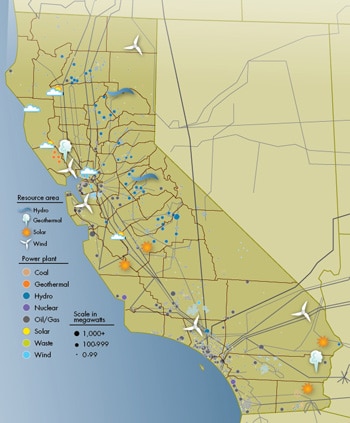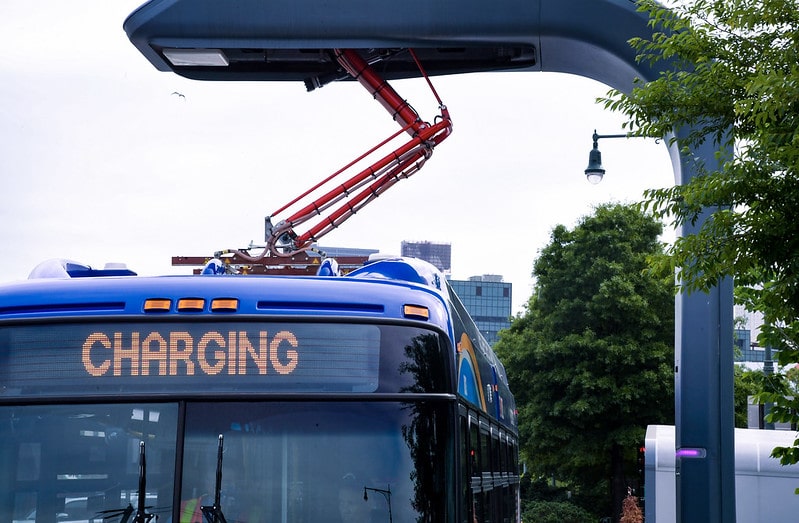A Duke Ellington lyric once told New Yorkers to “take the ‘A’ train.” That advice now might be to “take the ‘E’ bus” after the New York Power Authority (NYPA) and Metropolitan Transportation Authority (MTA) finalized a $39 million deal to install more than 50 overhead chargers to power new electric buses headed to New York City in 2022.
The new infrastructure is part of MTA’s plan to upgrade facilities to support its plan to buy only electric buses starting in 2028 and to have an all-electric 5,800-bus fleet by 2040. MTA officials said they plan to boost their electric bus buy this year from 45 to 60 vehicles.
Under the financing agreement, NYPA will provide and install overhead electric bus charging infrastructure for 45 buses at four locations in the boroughs of Staten Island, Brooklyn, Queens and, Manhattan. An on-street pantograph (a device mounted on an overhead structure that mates with electrical contacts on the bus’s roof to deliver power) at Williamsburg Bridge Plaza in Brooklyn will be replaced. On-street pantographs provide enough charge during the drivers’ rest periods to keep the bus operating for two full shifts per day.
The scope of work includes design, permitting, and providing and installing 53 overhead direct current fast chargers and related pantographs and gantry support systems. The overhead chargers will allow interoperability between buses from different manufacturers.
Two different vendors have been contracted to help complete the project: ABM and Verdek. Charging hardware will be supplied by ABB and Siemens. The project is expected to be completed within a year. The overhead chargers will have power levels ranging from 150 kW – 300 kW and the on-street charger will be 500 kW.
SEIA adds energy storage advocacy
The Solar Energy Industries Association (SEIA) launched the Storage Advocacy Network, a branch of the industry trade group to serve as a national and state advocacy voice for energy storage.
SEIA said it plans to offer one board of directors’ seat to the chair of its Storage Division and 10 free memberships to companies focused on energy storage. Through collaboration with various SEIA committees, the Storage Advocacy Network is expected to shape the organization’s lobbying and public affairs advocacy on energy storage.
SEIA said it will put its full weight behind state and federal policies that scale competitive energy storage deployment, increase private sector investment in storage, and create well-paying jobs across the entire storage value chain.
NERC warns of energy shortfall risks
A 2021 reliability assessment from the North American Electric Reliability Corp. (NERC) warns that parts of North America are at elevated or high risk of energy shortfalls this summer during above-normal high temperatures. (Read the report here.)

Image by Armin Forster from Pixabay
It said that Texas, New England, MISO, and parts of the West are at an “elevated risk” of energy emergencies. In the “high risk” category is California, which relies on large energy imports during peak demand scenarios and when solar resource output declines in the evening hours.
The assessment said that although more than 3 GW of additional resources are expected in California this summer compared to 2020, most will be solar photovoltaic (PV) generation. It said that these plants can provide energy to support peak demand, but output falls off in late afternoon while high demand often remains. NERC said that reliance on imports during these periods is an “increasing reliability risk.”
(Read “Agencies release final report into California’s heat-related blackouts.”)
It said that while actions taken by the California Public Utilities Commission, CAISO and utilities to procure additional resources will help, the Western Interconnection’s increase in demand and decline in resources may reduce the amount of surplus capacity available when California is in shortfall.
(Read “California adds more layers to its summer 2021 electric reliability effort.”

Image: CAISO
The assessment also said that wildfire season in the western United States and Canada poses risk to bulk power system reliability. It said that government agencies are warning of the potential for above-normal wildfire risk beginning in July in parts of the western United States as well as central and western Canada.
The summer assessment said that in Texas, on-peak planning reserve margins have increased to 15.3% from 12.9% last summer with the addition of 7,858 MW wind, solar, and battery resources. It said, however, that extreme weather can affect both generation and demand and cause energy shortages that lead to energy emergencies in the Electric Reliability Council of Texas (ERCOT). It added that with a “significant portion” of electricity supply coming from wind generation, operators must have sufficient flexible resources to cover periods of low-wind output.
The assessment said that MISO and NPCC-New England have sufficient resources for periods of peak demand. However, above-normal levels of demand are likely to exceed capacity resources and require additional non-firm transfers from surrounding areas.
The annual assessment said that all other areas have sufficient resources to manage normal summer peak demand and are at low risk of energy shortfalls from more extreme demand or generation outage conditions.
This content is protected by copyright and may not be reused. If you want to cooperate with us and would like to reuse some of our content, please contact: editors@pv-magazine.com.









By submitting this form you agree to pv magazine using your data for the purposes of publishing your comment.
Your personal data will only be disclosed or otherwise transmitted to third parties for the purposes of spam filtering or if this is necessary for technical maintenance of the website. Any other transfer to third parties will not take place unless this is justified on the basis of applicable data protection regulations or if pv magazine is legally obliged to do so.
You may revoke this consent at any time with effect for the future, in which case your personal data will be deleted immediately. Otherwise, your data will be deleted if pv magazine has processed your request or the purpose of data storage is fulfilled.
Further information on data privacy can be found in our Data Protection Policy.